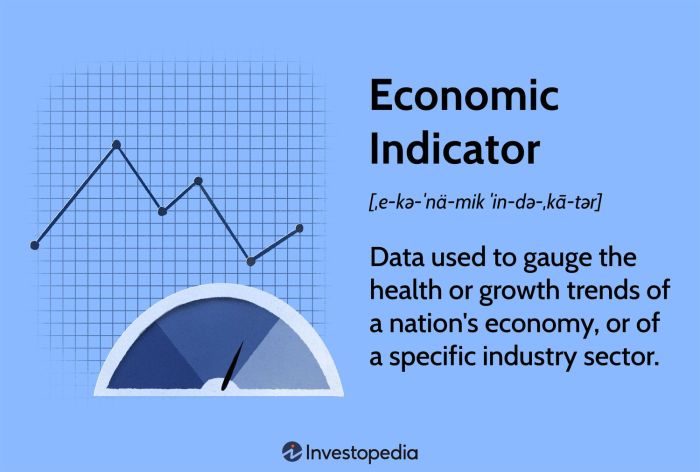Diving into the realm of Economic Indicators, we embark on a journey filled with insight and analysis, shedding light on the vital signs that drive economies worldwide. From leading indicators to key economic metrics, this narrative promises a deep dive into the pulse of financial landscapes.
Exploring the nuances of economic indicators unveils a world where numbers speak volumes, guiding decisions and strategies in the intricate dance of market dynamics.
Definition of Economic Indicators
Economic indicators are statistics that provide insights into the overall health and performance of an economy. These indicators help analysts, policymakers, and investors assess the current economic conditions and predict future trends.
Main Types of Economic Indicators
- Gross Domestic Product (GDP): GDP measures the total value of all goods and services produced within a country’s borders. It is a key indicator of economic performance.
- Unemployment Rate: This indicator shows the percentage of the labor force that is unemployed and actively seeking employment. A high unemployment rate can indicate economic weakness.
- Inflation Rate: Inflation measures the rate at which the prices of goods and services rise over time. It is crucial for assessing changes in purchasing power and overall economic stability.
- Consumer Confidence Index: This index reflects consumers’ attitudes towards the economy, indicating their willingness to spend. It can influence economic growth and consumer behavior.
Significance of Economic Indicators
Economic indicators play a vital role in analyzing the health of an economy by providing valuable information on various aspects such as growth, employment, inflation, and consumer behavior. They help decision-makers make informed choices, anticipate economic trends, and implement appropriate policies to support economic stability and growth.
Leading Economic Indicators

Leading economic indicators are statistics or data points that provide insight into the future direction of the economy. They are used by analysts and policymakers to forecast economic trends and make informed decisions.
Definition and Examples
Leading economic indicators include:
- Stock market performance
- Building permits
- Consumer confidence surveys
- Manufacturer’s new orders
These indicators are considered predictive because changes in them tend to precede shifts in the overall economy.
Forecasting Future Trends
By analyzing leading economic indicators, experts can anticipate changes in the economy before they happen. For example, a rise in building permits may indicate future growth in the construction industry, which can lead to increased job opportunities and consumer spending.
Impact on Decision-Making
Businesses and investors use leading economic indicators to make strategic decisions. For instance, if consumer confidence is high, businesses may increase production to meet anticipated demand. Similarly, investors may adjust their portfolios based on stock market performance forecasts.
Lagging Economic Indicators
Lagging economic indicators are indicators that follow changes in the economy and confirm trends that have already occurred. They reflect the impact of economic shifts and are used to assess the overall health of the economy.
Definition and Examples
Lagging economic indicators include data points that change after the economy has already started to follow a particular trend. Examples of lagging indicators are:
- Unemployment rate
- Corporate Profits
- Consumer Price Index (CPI)
- Outstanding consumer debt
Comparison with Leading Indicators
Lagging indicators differ from leading indicators in that they confirm trends that have already taken place, while leading indicators signal potential changes in the economy before they occur. While leading indicators help anticipate future economic conditions, lagging indicators provide confirmation of past trends.
Importance in Confirming Trends
Lagging indicators play a crucial role in confirming the direction of the economy. By analyzing lagging indicators, economists and policymakers can validate the trends identified by leading indicators and gain a more comprehensive understanding of the overall economic landscape. This confirmation helps in making informed decisions and predicting future economic conditions more accurately.
Key Economic Indicators
In the world of economics, key economic indicators play a crucial role in helping us understand the overall health of an economy. These indicators provide valuable insights into various aspects of economic activity and help policymakers, investors, and businesses make informed decisions.
Gross Domestic Product (GDP)
GDP is one of the most widely used economic indicators and serves as a measure of the total economic output of a country. It is calculated by adding up all the goods and services produced within a country’s borders. A rising GDP indicates economic growth, while a declining GDP may signal a recession.
Unemployment Rate
The unemployment rate measures the percentage of the labor force that is unemployed and actively seeking employment. A high unemployment rate can indicate economic distress, while a low rate suggests a healthy job market. This indicator is crucial for assessing the overall health of the labor market.
Consumer Price Index (CPI)
The CPI measures the average change in prices paid by consumers for goods and services over time. It is a key indicator of inflation and helps policymakers gauge the impact of price changes on consumers’ purchasing power. A rising CPI indicates inflation, while a falling CPI may signal deflation.
Interest Rates
Interest rates set by central banks play a significant role in influencing economic activity. Changes in interest rates can impact borrowing costs, investment decisions, and consumer spending. Lower interest rates typically stimulate economic growth, while higher rates can slow down the economy.
Retail Sales
Retail sales data provides insights into consumer spending patterns and overall economic activity. Rising retail sales indicate increased consumer confidence and economic growth, while declining sales may signal a weakening economy. This indicator is closely watched by businesses and investors to assess consumer behavior.
